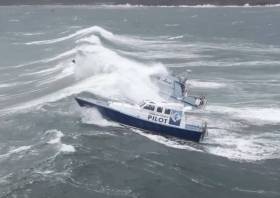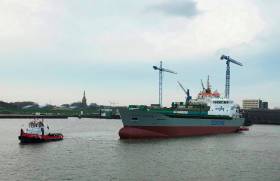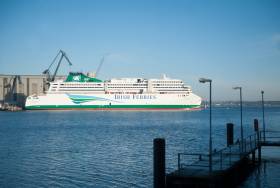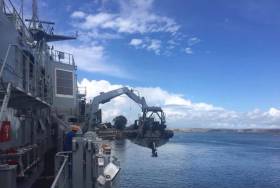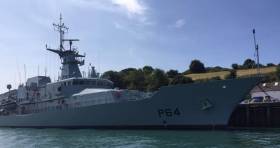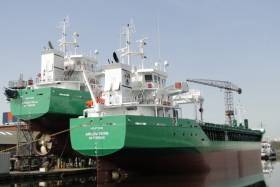Displaying items by tag: Sea Trials
In an update on Arklow Ranger, the fourth of seven Dutch shipyard completed Eco-Traders of the 6,800dwt / R class cargo ships, departed last month from its inland location to reach a seaport, writes Jehan Ashmore.
An Autumnal launch of the Arklow Ranger, which is just shy of 105m (LOA) length overall, took place in October as Afloat reported at the Royal Bodewes Shipyard at Hoogezand, near Groningen.
Following final works to prepare the Irish flagged cargo ship with a combined hold capacity of 310,000 cubic feet (cbft), the newbuild last month departed the shipyard.
This involved towage from the shipyard on the Winschoterdiep Canal and an onward connection via the Zeehavenkannaal to reach the Port of Delfzijl on the Ems estuary. From there took place the short passage to Eemshaven on 18 December, this in the same week prior to the start of the Festive Season.
It would appear that the last known activity of the Arklow Ranger occured the following day, after arriving at Eemshaven, as the newbuild currently remains at its berth in the Dutch north-eastern port.
As customary with the newbuilds Arklow Shipping have on order to Bodewes, that the shipbuilder's sea trails are conducted offshore of Emshaven. Such trials are carried out in the vicinity of The Frisian Islands, also known as the Wadden Sea Islands, which form an archipelago also off the neighbouring German coast.
Beyond the archipelago is the open waters of the North Sea from where Afloat will have more to report on this newest addition to the Irish Shipping Registrar.
Arklow's Latest Newbuild Enters Dutch-German Estuary this Afternoon to Start Sea Trials
Two months after launching, Arklow Rambler the third of seven Eco-Traders cargoships was towed from a Dutch inland shipbuilder and is this afternoon bound for the open sea, writes Jehan Ashmore.
The 104.93m length overall (LOA) dry-cargo ship built by Royal Bodewes shipyard at Hoogazand near Groningen, departed in the late morning on a tow to Delfzijl on the Ems estuary.
Towage duties of the 6,800 deadweight tonnes Arklow Rambler were carried out by the Waterpoort which has performed similar such tasks for many newbuilds ordered by Arklow Shipping Ltd. The newbuild is Irish flagged and likewise of the series so far completed.
Approximately two and half hours later the tow had reached the Port of Delfzijl located on the Dutch side of the estuary shared with Germany.
Waterpoort then continued as an escort of the Arklow Rambler which headed out of Delfzijl along the Zeehavenkannaal before entering the estuary as Afloat tracked at around 1615hrs (Irish time) today.
Arklow Rambler under its own engine power, is now underway to the Port of Emshaven and from there will use the port as a base in between shipbuilder sea trials.
Leadship of New Stena E-Flexer Class Completes Trials in China Ahead of Irish Sea Debut Next Year
Operator Stena Line has announced that the first of its three new E-Flexer class ferries destined for the Irish Sea, Stena Estrid has successfully completed sea trials in China’s Yellow Sea.
Following three days of extensive testing, the new vessel performed excellently across a wide range of stringent test criteria and is now on schedule to start operating on the Dublin to Holyhead route in early 2020 (see float-out as Afloat previously reported).
Stena Estrid is the first of five new Stena Line next generation RoPax vessels that are being constructed at the AVIC Weihai Shipyard in China, three of which will be introduced on the company’s Irish Sea routes from Dublin to Holyhead and Belfast to Liverpool.
Sister ship Stena Edda is due to enter on the Belfast-Liverpool route in spring 2020, with the third vessel Stena Embla expected to be introduced on the same route in early 2021.
Part of a multi-million pound investment in the region, the new Stena Line ships will be amongst the most advanced vessels in operation and larger than today’s standard RoPax vessels (*details below).
The sea trials are designed to ensure that all systems are fully operational and in line with strict specifications outlined by Stena Line, including areas such as engine performance and fuel consumption, navigation and radio equipment, emergency systems, speed tests, manoeuvrability, engine and thruster tests, and safety tests.
“Today the first of our five next generation ferries achieved a very important milestone” said Stena Line’s Paul Grant, Chief Commercial Officer, Irish Sea and North Sea.
“Sea trials are a critical phase in a new ship’s development, as our first opportunity to take a new vessel out to sea, put her through her paces and test that she is up to the high standards required by Stena Line.
“We systematically go through all aspects of the new ship and I am pleased to say that Stena Estrid has successfully completed every trial. We now look forward to the full handover of the vessel by the shipyard and to starting her journey to the Irish Sea,” he added.
Stena Line CEO Niclas Mårtensson said that the introduction of Stena Estrid and her sister ships reflected the company’s commitment to the Irish Sea.
“The Irish Sea is very important to Stena Line’s global business and represents a significant part of our overall revenue,” said Mr Mårtensson.
“We strongly believe that our ferry business on the Irish Sea will continue to grow and it remains a key region for the company, as evidenced by our continued investment and the addition of three new vessels, underscoring Stena Line’s commitment to our Irish Sea operations and our determination to deliver the best possible freight and travel experience to our customers.
“Stena Estrid will bring many benefits to our customers including speedy and efficient loading and unloading operations, plus further development of our Scandinavian-inspired facilities including our restful and bespoke Hygge Lounge and the latest upgrade of our premium product, the Stena Plus concept. The new ships will be spacious, light and make great use of panoramic views,” added Niclas.
“This is a very exciting time for our business and I’m proud that as Europe’s largest ferry company, Stena Line continues to shape the industry for the next generation of freight and travel customers,” he concluded.
At 215 metres in length, Stena Estrid and her sister ships for the Irish Sea will be larger than today’s standard RoPax vessels and will provide freight capacity of 3,100 lane meters and the space to carry 120 cars and 1,000 passengers and crew.
Next up for Estrid is an official handover ceremony at the shipyard before she sets sail on the long journey from China to the north Wales port of Holyhead.
STENA ESTRID FAST-FACTS
The name Estrid is connected to Stena Line’s Scandinavian heritage. It is an Old Norse eastern-Nordic version of the name Astrid. Estrid is commonly found on old runestones and means ‘divinely beautiful’.
Builder: AVIC Weihai Shipyard Co (Weihai, China)
Type: Ro-Pax ship
Ferry route / homeports: Dublin-Holyhead
Speed: 22 kn / 41 kph / 25 mph
Length (LOA): 215 m / 705 ft
Beam (width): 28 m / 92 ft
Gross Tonnage: 42400 gt
Lane Metres: 3,100
Passengers: 1000
Cars: 120
Freight vehicles: 210
Cabins: 175
Stena Line is the largest ferry operator on the Irish Sea, offering routes between Ireland and Britain including Dublin-Holyhead, Rosslare-Fishguard, Belfast-Cairnryan, and the Belfast to Liverpool and Heysham (freight only) routes. In addition a direct route to mainland Europe, Rosslare-Cherbourg with three return crossings a week.
Safehaven Marine have shared new video from rough weather sea trials for its latest pilot boat, Dalmore, as well as its new XSV20 named Safehaven.
As previously reported on Afloat.ie, Dalmore is an Interceptor 48 — the 15th of this model, and 40th pilot boat overall for Safehaven Marine — commissioned by the Port of Cromarty Firth in Scotland.
Also on trial was the Cork-based extreme performance boatbuilder’s latest XSV20, which is soon to take up residence in the Bay of Biscay.
Safehaven follows Thunder Child II, the next generation of the piercing monohull class that will now see its world record Transatlantic attempt take place in summer 2020 — thanks in part to the busy business’ full order book this year.
Forest Products Carrier Takes to the Seas for First Trials
#Ports&Shipping- Specialist forest carrier operator, ScotLine which operates regular services to Irish ports, last week saw their latest newbuild take to the seas for first trails, writes Jehan Ashmore.
Since Scot Carrier's christening launch ceremony in September, the 4,800dwt short-sea timber trader, now the largest of the fleet has undergone outfitting. Last week the 90m long cargoship which has a beam of 15m departed on a canal journey under towage from the Dutch inland shipyard of Royal Bodewes in Hoogezand to Delfzijl.
From there Scot Carrier sailed under its own propulsion (Mak engine) to Eemshaven having made the passage through the Ems Estuary to enter the open sea. According to Royal Bodewes the inaugural sea trial in the North Sea was successfully executed.
Furthermore, Afloat today tracked Scot Carrier undergoing trials again having departed Emshaven, from where the newbuild is at time of writing offshore of Esbjerg, Denmark.
Scot Carrier has been given an ice class 1B classification which is important for Baltic customers of the operator, which primarily runs 'liner' services around Northern Europe with regular routes between Ireland, Denmark, Sweden, Norway and Germany. In addition to liner links calling to ports in the UK, France and The Netherlands.
The newbuild will join fleetmates that in addition to transporting forest products also can vary in loading a variety of bulk and project cargoes.
#FerryNews - While Irish Ferries flagship Ulysses is currently out of service, Afloat also reports on the much delayed €150m cruiseferry W.B. Yeats which is finally to begin sea-trials in the Baltic Sea, writes Jehan Ashmore.
W.B. Yeats last night departed the shipbuilder, Flensburger Schiffbau-Gesellschaft (FSG) in Flensburg. The shipyard located close the Danish border, experienced delays in the fitting out of interior components for public areas and on the electrical system installation in the hull and deckhouse.
According to FSG, back in June, the shipyard stated that entry into service is now planned for September. This final stage of construction work subcontracted by FSG, was further pushed back and so delayed again the debut of the 1,885 passenger/1,200 vehicles capacity cruiseferry which has accommodation in 435 cabins.
The largest ferry that is to connect Ireland-France, W.B. Yeats at 54,985 gross tonnage, was originally to start service on 12 July, firstly on the Dublin-Cherbourg route followed in September by a transfer to the Holyhead route in the winter months. As during that timeframe, ropax ferry Epsilon maintains the year round operated link connecting the Irish capital and France.
The postponement of W.B. Yeats by FSG, left Irish Ferries in a difficult situation that led to major disruption as sailings were cancellations during the peak-season. This involved affecting to varying degress the travel plans of thousands of holidaymakers.
Passengers were given the option of travelling on the company's more established continental routes through Rosslare served by cruiseferry Oscar Wilde which Afloat reported today has been operating this month both to Holyhead and Cherbourg on routes based out of Dublin.
Oscar Wilde since yesterday has begun covering the Rosslare -Pembroke route while routine cruiseferry Isle of Inishmore took over the sailing roster of Ulysses. The flagship as alluded in the introduction is off service from the Dublin-Holyhead route due to technical reasons.
Naval Service's Latest P60 Class Newbuild George Bernard Shaw On Sea-Trials in Bristol Channel
#NavalService - Afloat has tracked the Irish Naval Service's latest offshore patrol vessel carry out sea-trials which involved the €67m newbuild in the Bristol Channel while off the north Devon coast from where the ship was built, writes Jehan Ashmore.
The newbuild George Bernard Shaw is the fourth sister of the P60 class built in the UK yard of Babcock Marine & Technology in Appledore from where the OPV90 ship yesterday evening departed for sea-trials. The shipyard (see previous report) is located close to Bideford on the River Torridge. The facility is also where a previous generation belonging to a pair of P50 class were completed. These smaller OPV80 sisters (the figure referring to the hull length) were built at the same site of the Babcock shipyard albeit then run by Appledore Shipbuilders.
The sea-trial saw the 23-knot capable P60 newbuild head as far west offshore of Hartland Point and later to the east but approach much closer to the shore off Illfracombe. Following these manouveres the 90m newbuild headed further west involving a figure of eight loop when off Lundy Island, before returning to the Bristol Channel.
At 2,250 tonnes the P60 class newbuild, likewise of sisters form the largest in tonnage terms in the navel fleet. The newbuild comes equipped with a comprehensive command, control and communications package while the main weapon consists of a 76mm bow-mounted gun. Installation of the gun as previously reported will be fitted later this year at the Irish Naval Service base located in Cork Harbour.
As for a delivery date to the Naval Service, this is subject to the completion of successful sea trails before a voyage can be made to the Naval Base on Haulbowline Island opposite Cobh.
The OPV by then in Irish waters will be formally named 'L.E. George Bernard Shaw' and commissioned into the Irish Naval Service.
Newest Naval Service P60 Class, George Bernard Shaw Nears Completion - Trials In September
#NavalService - The newest Irish Naval Service OPV vessel, George Bernard Shaw is nearing completion at the fit-out quay alongside Appledore in the UK, from where the next set of sea trials is scheduled for September, writes Jehan Ashmore.
The €67m newbuild contracted to Babcock Marine, at the shipyard in north Devon, represents the fourth of the P60 Offshore Patrol Vessels, also dubbed the 'Playwright' class. They are leadship LÉ Samuel Beckett commissioned in 2014, LÉ James Joyce in 2016 and LÉ William Butler Yeats that joined the fleet in 2016.
The delivery date of the newbuild is subject to the completion of successful sea trails before a voyage can be made to the Naval Base in Haulbowline, Cork Harbour. The OPV when completed will be formally named and commissioned into the Naval Service later this year.
Design origins of the P60 class newbuild is based from an enhanced version of two smaller P50 OPV80 series otherwise known as the 'Róisín' class. The predecessor class, still in service, comprises of LÉ Róisín which was commissioned into service in 1999 while sister LÉ Niamh entered in 2000.
Unlike the George Bernard Shaw (P64) and sisters, the Róisín class were built by Appledore Shipbuilders, albeit at the same site now occupied under the name of Babcock Marine & Technology. The facility is located at the Bidna Yard on the banks of the River Torridge downriver of Bideford which has access to the open sea on the Bristol Channel.
Based at the Devon yard is a Naval Service Onsite Project Team: Lt Cian Ryan, (P64) Project Manager, S/Lt Sean Lenehan, CPO Brian Attridge,PO Paul Mullane,PO James Quigg and PO Cormac O'Sullivan. For further coverage of the newbuild and about the Irish born Nobel and Oscar Winning playwright click download: 'Maritime Dalkey' published May 2018 issue of the Dalkey Community Council Newsletter (p.19).
As Afloat previously covered, George Bernard Shaw which was given a night-time float-out in March when the OPV's hull (at just under 90m) emerged into the estuary. The longer hull differs to the Róisín pair of 78m. Among the reasons for this lengthening, likewise of all the P60 class, is to enable increased aft deck space for container storage if required and to improve shiphandling characteristics.
The new OPV of around 2,250 tonnes will have a comprehensive command, control and communications package along with a main weapon, a 76mm bow-mounted gun. According to the Department of Defence, the installation of the armanent will however not take place at the UK yard but later this year at the Irish Naval Base.
A pair of twin screw propellers will deliver 23 knots and a 6,000 miles range is based on a cruising speed of 15 knots. Accommodation is for 44 crew and berths for an additional 10 trainees
For rescue operations and a range of tasks including ilegal fishing and pollution duties (see 'Drone' use story) , a suite of three rigid inflatable boats (RIBS) are equipped.
The RIBS will enable the OPV to act as a mother ship, as demonstrated by sisters in recent years during the Meditterranean migrant /refugee crisis. Currently, LE James Joyce is deployed in the same region as part of Operation Sophia duties involving other navies tasked in combating people smuggling.
#Ports&Shipping - Arklow Viking began sea trials yesterday, the brand new short-sea trader having been towed from an inland Dutch yard to the North Sea, writes Jehan Ashmore.
The 2,999grt Arklow Viking marks the 9th of ten multipurpose cargoships that will serve Arklow Shipping Nederland B.V. The class constructed by Royal Bodewes shipyard are built to an in-house design, the Eco-Trader 5150 series.
It was on Monday, that a pair of tugs towed the 89m Arklow Viking from the yard in Hoogezand near Groningen on the canal network to Delfzijl on the Ems Estuary. The newbuild undertook sea trials and when not underway the vessel in based out of Emshaven.
As for final sister of this series, the newbuild is to be named Arklow Villa and as revealed on the stern, the port of registry is Rotterdam. This is not surprising as ASN are based in the giant deep-water port.
Around 50 cargoships operate under the Irish and Dutch flagged fleet, they mostly comprise of short-sea traders in addition to deep-sea bulkers.


























